Collecting USA pottery has become a beloved hobby for many, but identifying its marks can be tricky without the right knowledge. That’s where a USA pottery marks identification guide comes in handy. In this guide, we’ll explore common marks from popular makers, tips for identifying them accurately, and even how to gauge the value of your finds.

1. Understanding USA Pottery
1.1. The history of American pottery
USA pottery dates back to the 18th and 19th centuries, starting with small regional workshops producing functional items like bowls, pitchers, and plates. Over time, pottery evolved from purely practical items into collectible art pieces. By the early 20th century, American potteries were experimenting with decorative glazes, unique shapes, and bold designs, creating the beloved collectibles we see today.
1.2. Styles and types of USA pottery
American pottery is incredibly diverse. You’ll find everything from simple stoneware and earthenware to elaborate art pottery. Some pieces feature hand-painted designs, while others showcase embossed textures or slip decoration. Major styles include:
- Art pottery: Decorative and artistic, often collectible
- Stoneware: Durable and functional, popular for kitchenware
- Earthenware: Lightweight, often brightly colored
- Majolica: Glossy, colorful glazes with relief designs
1.3. Key periods of USA pottery production
Certain time periods were especially significant for USA pottery:
- Early 1900s (1900–1930s): The rise of decorative art pottery and regional styles
- Mid-20th century (1940s–1960s): Mass production with unique glazes and modern designs
- Post-1960s: Studio pottery and limited editions became popular
Recognizing the era of a piece can give you clues about its mark, style, and value.

See more: how to identify pottery by glaze, clay, texture, and marks
2. Common USA pottery marks
2.1. Red Wing pottery marks
Red Wing Pottery, founded in Minnesota in the late 1800s, is famous for stoneware and dinnerware. Their marks often include the company name and sometimes a number indicating the mold or pattern. Older pieces may feature simple “Red Wing” stamps, while mid-20th-century items might have a circular logo with “Red Wing, USA.”
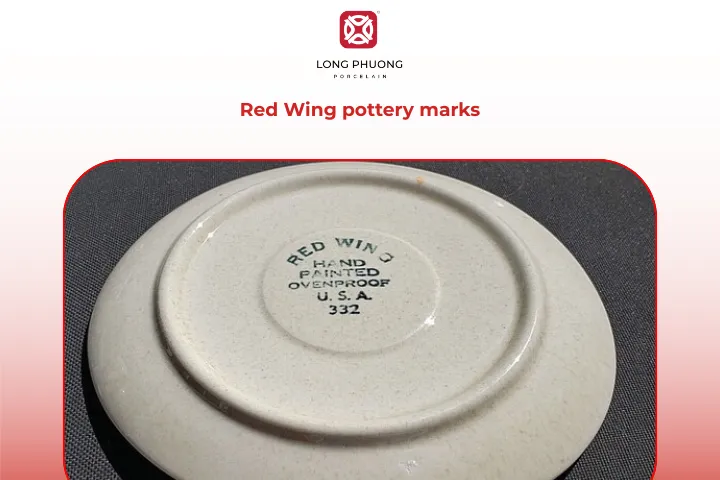
2.2. Roseville pottery marks
Roseville Pottery, a staple in American art pottery, used both word marks and embossed logos. Many pieces include “Roseville” and the shape or pattern name, sometimes with a date code. Collectors look for these marks to distinguish authentic Roseville from reproductions.
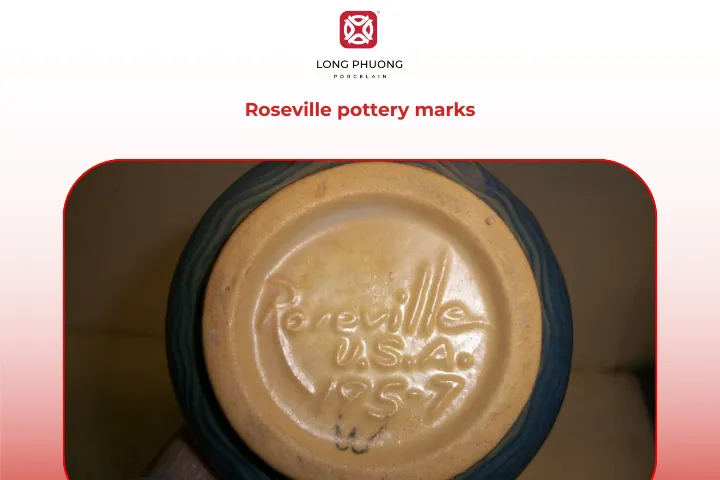
2.3. McCoy pottery marks
McCoy is perhaps one of the most collectible names in American pottery. Their marks vary depending on the era, but often include “McCoy” stamped in uppercase letters. Some pieces also have “USA” stamped alongside, which can help date the item to mid-20th-century production.
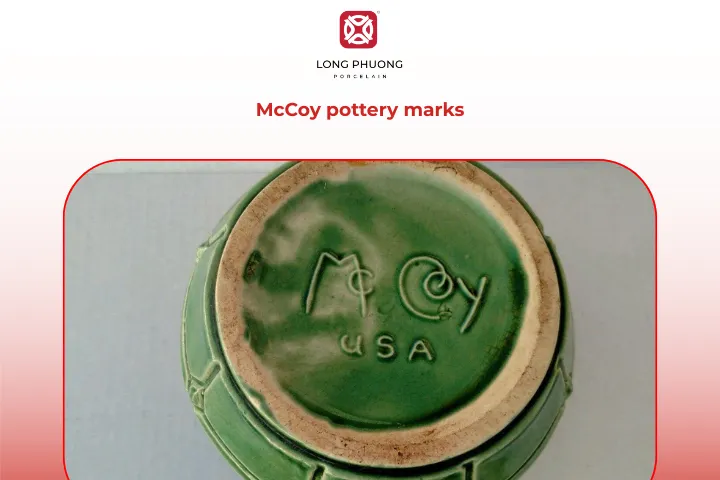
2.4. Hull pottery marks
Hull Pottery produced colorful art pottery and utilitarian ware. Marks usually include “Hull” and sometimes a shape number. Later pieces might have additional symbols, and knowing the variations helps collectors accurately identify and date their Hull pieces.

2.5. Other notable USA pottery markers
Other American potteries worth knowing include:
- Shawnee Pottery: Recognizable for its whimsical designs and logo marks with the word “Shawnee.”
- Bauer Pottery: Often marked with “Bauer USA,” sometimes including the shape number.
- Weller Pottery: Frequently includes “Weller” and occasionally the pattern name or a distinctive logo.
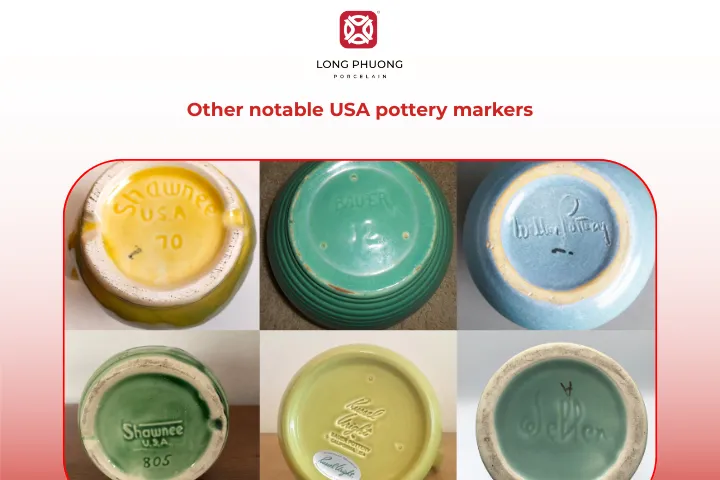
3. Discover the USA pottery marks identification guide
3.1. Tools and resources for identification
Before you start, gather a few tools that will make the process smoother:
- Magnifying glass: Some marks are tiny or worn, requiring close inspection.
- Pottery guides and books: Comprehensive guides can show marks with images for comparison.
- Digital databases: Online resources, such as collector forums, museum archives, or auction sites, can help verify marks.
- Notebook or app: Keep records of your findings, including photos, descriptions, and references.
3.2. Step-by-step identification process
Here’s a simple roadmap to follow when examining a piece:
- Examine the bottom of the piece: Most marks are located on the base or underside. Look for stamps, engravings, or embossed symbols.
- Take note of the style and shape: Shape and design can help narrow down possible makers.
- Compare with references: Use books, catalogs, or online databases to match the mark.
- Check for date or pattern codes: Many manufacturers included numbers indicating production year or shape.
- Verify authenticity: Look for consistent style, glaze, and mark placement to avoid misidentifying reproductions.
3.3. Tips for distinguishing authentic marks from reproductions
- Look for wear patterns: Genuine older pieces usually show natural wear on the base and edges.
- Examine glaze quality: Reproductions often have brighter, inconsistent glazes.
- Research known reproductions: Some popular marks, like McCoy or Roseville, have commonly reproduced designs. Knowing these helps prevent mistakes.
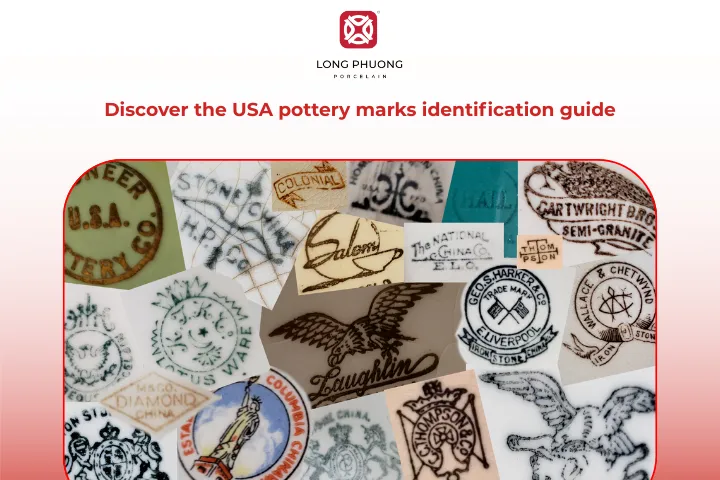
4. Evaluating the value of USA pottery
4.1. Factors affecting value
Several key factors influence a piece’s collectible value:
- Age: Older pieces, especially those from the early 20th century, often hold more value.
- Rarity: Limited editions, discontinued lines, or unique designs are highly sought after.
- Condition: Chips, cracks, or worn marks can decrease value, while well-preserved pieces command higher prices.
- Maker and mark clarity: Clear, identifiable marks from well-known potteries typically boost value.
4.2. How marks impact collectibility
Pottery marks do more than identify a maker; they also authenticate a piece. A clear, recognizable mark can turn an ordinary vase into a collectible gem. Collectors often search specifically for items with distinct or rare marks, sometimes paying premium prices for unusual variations.
4.3. Examples of high-value pieces and their marks
- Early Red Wing stoneware jugs: Clearly stamped “Red Wing” with model numbers, often selling for hundreds of dollars.
- Roseville “Della Robbia” pottery: Distinct embossed marks and patterns from the 1920s–1930s, highly collectible.
- McCoy cookie jars: Certain shapes and designs with clear “McCoy USA” stamps fetch significant sums at auctions.
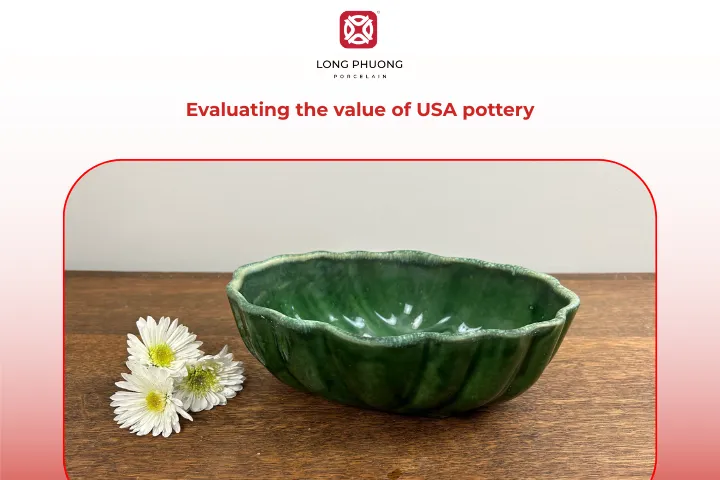
See more: how to identify authentic italian ceramic maker marks
5. Common mistakes in USA pottery mark identification
Even experienced collectors can make errors when identifying USA pottery marks. Avoiding these common pitfalls will save you time, money, and frustration while ensuring you accurately understand your pieces.
5.1. Misreading marks
Some marks are tiny, worn, or partially obscured, making them tricky to read. It’s easy to confuse letters or numbers, which can lead to misidentifying the maker or era. Always use a magnifying glass and compare the mark to trusted references before concluding.
5.2. Confusing similar marks from different makers
Many American potteries used similar symbols or initials, which can cause mix-ups. For example, “USA” appears on multiple mid-century pottery pieces. Paying attention to the font, placement, and style of the mark can help distinguish between manufacturers.
5.3. Overestimating value without proper research
Just because a piece looks old or carries a recognizable mark doesn’t automatically make it valuable. Condition, rarity, and demand all affect worth. Consulting price guides, auction results, and expert appraisals is essential to avoid overestimating a piece’s value.

6. Long Phuong Porcelain elevates your collection
Other than USA pottery, high-quality modern porcelain can also enhance your collection. Long Phuong Porcelain offers premium porcelain items that combine traditional craftsmanship with contemporary design. Long Phuong’s products showcase our precise markings, attention to detail, and quality materials. Each piece is carefully crafted, ensuring consistency, durability, and a flawless finish.

7. Conclusion
Identifying USA pottery marks is like unlocking a hidden story behind each piece. By learning to recognize these marks, you can confidently explore the fascinating world of American pottery. Whether you’re collecting for fun, investment, or simply appreciation, a USA pottery marks identification guide is an invaluable tool to make your journey easier and more enjoyable.
Related articles
CEO of Long Phuong Group Joint Stock Company, with more than 20 years of exploration and research to obtain the best formulas and professional experience, Long Phuong Porcelain has produced more than 400 designs of all kinds of household porcelain, Significant contributions to Vietnam's ceramic industry.
 Vietnam
Vietnam
